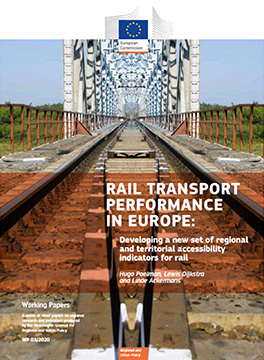Rail transport performance in Europe

Developing a new set of regional and territorial accessibility indicators for railHugo Poelman, Lewis Dijkstra and Linde Ackermans
Abstract
This paper presents a detailed analysis of the performance of rail passenger services using an accessibility framework developed with the International Transport Forum and the Organisation for Economic Co-operation and Development, along with a near-complete collection of Europe-wide rail timetables. The framework compares the population that can be easily reached by train to the total population living nearby, in order to measure how well the rail system performs. This analysis starts from the more than 2 million inhabited grid cells of 1 km2 in the EU, the European Free Trade Association (EFTA) countries and the United Kingdom. The detailed information allows us to assess rail services at the national, regional and local levels. At the national level, Spain, Denmark, Austria and Switzerland have the highest rail transport performance, while Lithuania and Romania score lowest. Cities consistently perform better than towns, suburbs and rural areas in all countries. However, some cities score better than others: large cities with frequent service do well, as do smaller cities with a fast connection to a nearby large city. There are 72 cities with no rail services during peak hours. Comparing rail trips combined with either a short walk or a bike ride to and from the train station shows that the combination with a bike ride more than doubles rail performance. Given the relatively low cost of providing bike infrastructure and promoting active mobility and micro-mobility, including e-bikes and e-scooters, this is likely to be a highly cost-effective way of promoting more rail travel.
